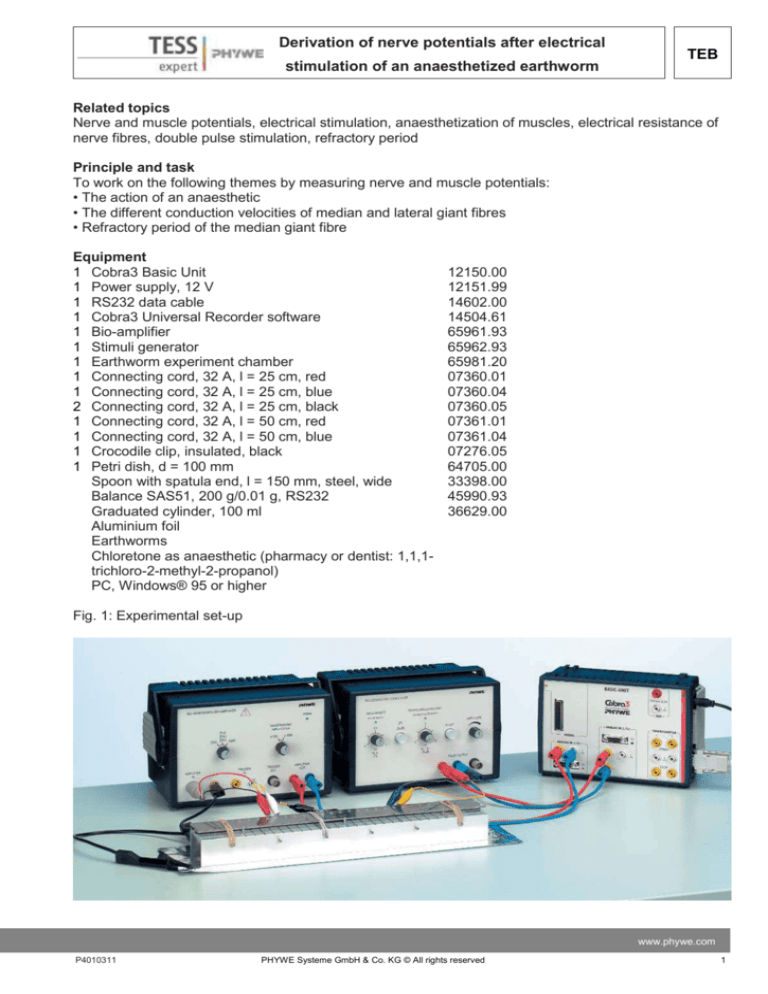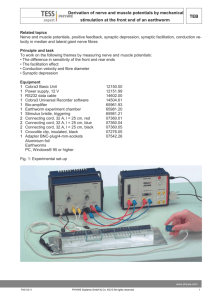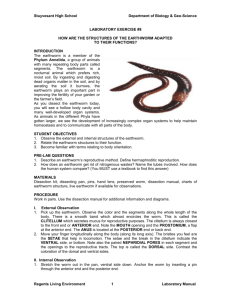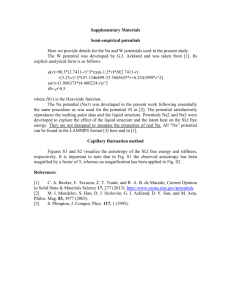
Derivation of nerve potentials after electrical
stimulation of an anaesthetized earthworm
TEB
Related topics
Nerve and muscle potentials, electrical stimulation, anaesthetization of muscles, electrical resistance of
nerve fibres, double pulse stimulation, refractory period
Principle and task
To work on the following themes by measuring nerve and muscle potentials:
• The action of an anaesthetic
• The different conduction velocities of median and lateral giant fibres
• Refractory period of the median giant fibre
Equipment
1 Cobra3 Basic Unit
1 Power supply, 12 V
1 RS232 data cable
1 Cobra3 Universal Recorder software
1 Bio-amplifier
1 Stimuli generator
1 Earthworm experiment chamber
1 Connecting cord, 32 A, l = 25 cm, red
1 Connecting cord, 32 A, l = 25 cm, blue
2 Connecting cord, 32 A, l = 25 cm, black
1 Connecting cord, 32 A, l = 50 cm, red
1 Connecting cord, 32 A, l = 50 cm, blue
1 Crocodile clip, insulated, black
1 Petri dish, d = 100 mm
Spoon with spatula end, l = 150 mm, steel, wide
Balance SAS51, 200 g/0.01 g, RS232
Graduated cylinder, 100 ml
Aluminium foil
Earthworms
Chloretone as anaesthetic (pharmacy or dentist: 1,1,1trichloro-2-methyl-2-propanol)
PC, Windows® 95 or higher
12150.00
12151.99
14602.00
14504.61
65961.93
65962.93
65981.20
07360.01
07360.04
07360.05
07361.01
07361.04
07276.05
64705.00
33398.00
45990.93
36629.00
Fig. 1: Experimental set-up
www.phywe.com
P4010311
PHYWE Systeme GmbH & Co. KG © All rights reserved
1
TEB
Derivation of nerve potentials after electrical
stimulation of an anaesthetized earthworm
Set-up
— Connect the instruments as shown in Fig. 1.
— Place the earthworm experiment chamber on aluminium foil and remove the lid
— Connect the bio-amplifier AMPLIFIER IN to the pins or the sheet metal of the chamber, so that the +
electrode is 3 cm and the – electrode 4 cm away from the rear end of the worm. Fix the sheet metal
for earthing the worm between the lid of the chamber and the earthworm (Fig. 2)
— Connect the earthed socket of the bio-amplifier to the earthing socket of the chamber, and to the aluminium foil (with the crocodile clip)
— Connect the bio-amplifier AMPLIFIER OUT to Cobra3 ANALOG IN 2 (red to +, blue to -)
— Connect the stimuli generator PULSE OUTPUT to Cobra3 ANALOG IN 1 (red to yellow, blue to
white)
— Connect the stimuli electrodes also to the PULSE OUTPUT of the stimuli generator (red to +, blue to
-). Fasten the crocodile clip of the positive pole to the pin which is 3 cm away from the rear of the
earthworm, the crocodile clip of the negative pole to the pin which is 4 cm away from it
— Set the bio-amplifier to EMG, amplification 1000 times
— Set the stimuli generator to single pulse, 0.5 ms pulse width, amplitude at the middle setting
Fig. 2: Earthworm experiment chamber
Procedure
— Call up the COBRA3 MEASURE programme in Windows
— Select the UNIVERSAL WRITER as measuring instrument
— Set the measurement parameters (see Fig. 3) and go to measurement with CONTINUE
— Switch on the stimuli generator, press the START switch and measure the amplitude of the stimulus.
Repeat the test measurements to adjust the amplitude to 3.5 V
— Wash and dry the earthworm and place it in the groove in the chamber. Prevent the earthworm from
crawling out of the chamber by appropriately positioning the lid and rubber bands, and the pieces of
sponge rubber at the two ends of the groove
Experiment 1:
— Click on the red point and go to measurement with CONTINUE
— Stimulate the earthworm (not yet anaesthetized) with a rectangular impulse of 3.5 V and save the result
— Dissolve 0.2 g chloretone in 100 ml of warm tap water and anaestethize the earthworm in a Petri dish
with this solution for 5 to 10 minutes
— Lay the benumbed animal carefully in the chamber. Caution! Do not hold the earthworm at its ends,
as it would then be drawn out extremely long, because of the numbness of the dermal muscular tunic!
— Stimulate the earthworm with a rectangular impulse of 3.5 V as previously and save the result. Should
no action potential appear, slightly increase the stimulating voltage or wait a few minutes until the effect of the anaesthetic weakens
2
PHYWE Systeme GmbH & Co. KG © All rights reserved
P4010311
Derivation of nerve potentials after electrical
stimulation of an anaesthetized earthworm
TEB
Experiment 2:
— Click on the red point and go to measurement with CONTINUE
— Stimulate the benumbed earthworm with smaller and smaller rectangular impulses; to do this, decrease the stimulus amplitude in steps of 0.1 V until there is no action potential more to be seen.
Experiment 3:
— Click on the red point and go to measurement with CONTINUE
— Set the stimulus amplitude to a value at which only one action potential is evoked (see Experiment 2).
Switch from single pulse to double pulse with 10 ms interval
— Stimulate the benumbed earthworm with double pulses at continually smaller intervals; to do this, reduce the double pulse interval in steps of approximately 1 ms until only one action potential appears.
Fig. 3: Measurement parameters
Results and evaluation
— Experiment 1: Prior to being anaesthetized, the animal reacts with muscle potentials, which are preceded by action potentials, which overlap each other and can therefore not be properly individually interpreted. With the anaesthetized animal, the anaesthetic paralyzes the dermal muscular tunic, so
that muscle potentials no longer appear. Two action potentials can be recognized; first the action potential of the median giant fibre and then that of the lateral giant fibre (Fig. 4).
To estimate the conduction velocity v, take the conducting time t as the distance between the maximum and minimum of the action potential (0.45 ms for the median giant fibre in Fig. 4). The stretch
covered s, i.e. the distance between the electrodes, is 1 cm. Using the equation v = s/t, the conduction velocity is found to be 22.2 m/s.
Fig. 4: Result with a strong stimulus
www.phywe.com
P4010311
PHYWE Systeme GmbH & Co. KG © All rights reserved
3
TEB
Derivation of nerve potentials after electrical
stimulation of an anaesthetized earthworm
— Experiment 2: Because of its lower electrical resistance, the thicker median fibre requires a smaller
depolarizing voltage than the thinner lateral giant fibre. On decreasing the exciting voltage to 3.9 V, only
the median giant fibre responds (Fig. 5), and on further decreasing it, no action potential at all appears.
Fig. 5: Result with infrequent strong stimulation
— Experiment 3: With double pulses at large time intervals, two action potentials appear which are distinctly separate from each other (Fig. 6). On reducing the time interval between the double pulses, the
action potentials first approach each other and subsequently the second action potential gets smaller
and smaller until it completely disappears (Fig. 7). From the time interval between the double pulses at
which only one action potential is triggered, we have as an approximation a refractory period of approx.
2.9 ms.
Fig. 6: Result with a double pulse 6 ms
4
PHYWE Systeme GmbH & Co. KG © All rights reserved
P4010311
Derivation of nerve potentials after electrical
stimulation of an anaesthetized earthworm
TEB
Fig. 7: Result with a double pulse 3 ms
Notes
— On Experiment 1: When the animal lies too long in the anaesthetic solution, the substance diffuses into the ventral cord and neither action potentials nor muscle potentials are recorded.
The distinct difference in the conduction velocities of the giant fibres is explained by the difference in the fibre diameters. As the lateral fibres have a smaller conducting cross-section and so
a greater longitudinal resistance, the excitation cannot propagate as quickly in them as in the
median giant fibre.
www.phywe.com
P4010311
PHYWE Systeme GmbH & Co. KG © All rights reserved
5
TEB
Derivation of nerve potentials after electrical
stimulation of an anaesthetized earthworm
Space for notes
6
PHYWE Systeme GmbH & Co. KG © All rights reserved
P4010311


![Earthworm Lab [1/16/2014]](http://s3.studylib.net/store/data/007071636_1-f0a789e538fb90aecda95ecf7b0a3557-300x300.png)







